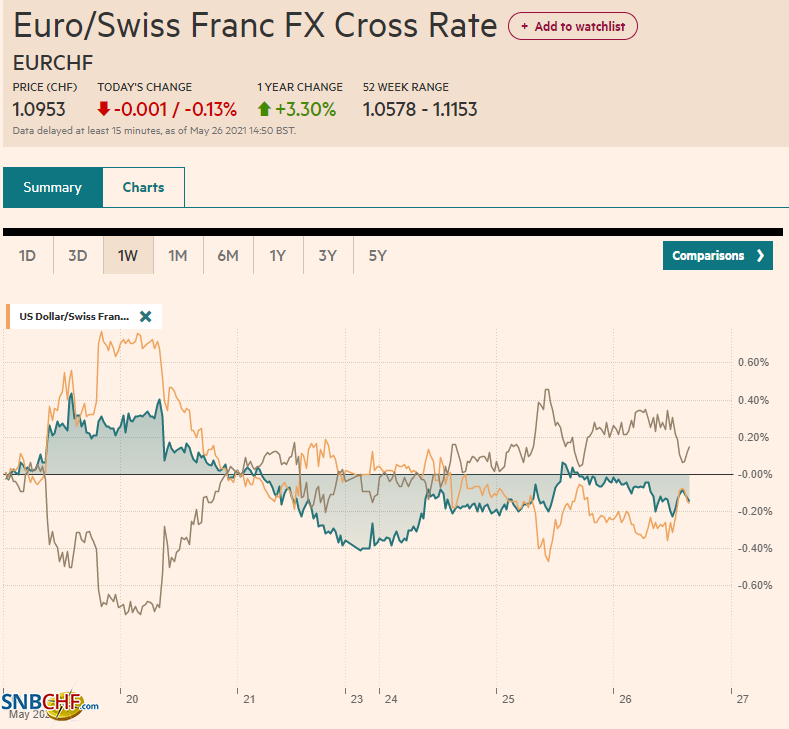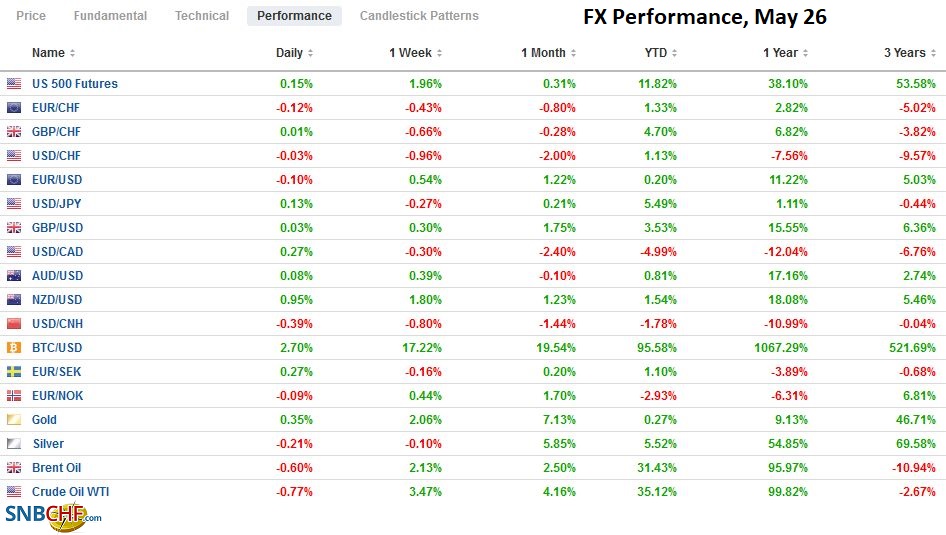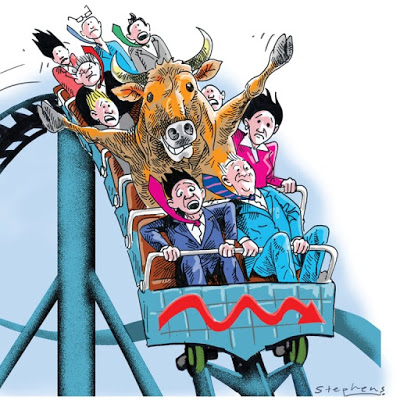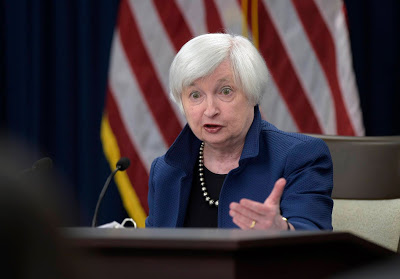Swiss Franc The Euro has fallen by 0.13% to 1.0953 EUR/CHF and USD/CHF, May 26(see more posts on EUR/CHF, USD/CHF, ) Source: markets.ft.com - Click to enlarge FX Daily Overview: The decline in US rates and the doves at the ECB pushing back against the need to reduce bond purchases next month have seen European bond yields unwind most of this month’s gain. The inability of US shares to hold on to early gains yesterday did not deter the Asia Pacific and European equities from trading higher. Only Australian and South Korean markets did not participate in the MSCI Asia Pacific Index’s fifth consecutive advance today. Europe’s Dow Jones Stoxx 600 is also ending higher for the fifth session. US future indices are around 0.25%. The US 10-year is holding around
Topics:
Marc Chandler considers the following as important: 4.) Marc to Market, 4) FX Trends, China, commodities, Currency Movement, EUR/CHF, Featured, Federal Reserve, Hungary, newsletter, RBNZ, USD, USD/CHF
This could be interesting, too:
Nachrichten Ticker - www.finanzen.ch writes Die Performance der Kryptowährungen in KW 9: Das hat sich bei Bitcoin, Ether & Co. getan
Nachrichten Ticker - www.finanzen.ch writes Wer verbirgt sich hinter der Ethereum-Technologie?
Martin Hartmann writes Eine Analyse nach den Lehren von Milton Friedman
Marc Chandler writes March 2025 Monthly
Swiss FrancThe Euro has fallen by 0.13% to 1.0953 |
EUR/CHF and USD/CHF, May 26(see more posts on EUR/CHF, USD/CHF, ) Source: markets.ft.com - Click to enlarge |
FX DailyOverview: The decline in US rates and the doves at the ECB pushing back against the need to reduce bond purchases next month have seen European bond yields unwind most of this month’s gain. The inability of US shares to hold on to early gains yesterday did not deter the Asia Pacific and European equities from trading higher. Only Australian and South Korean markets did not participate in the MSCI Asia Pacific Index’s fifth consecutive advance today. Europe’s Dow Jones Stoxx 600 is also ending higher for the fifth session. US future indices are around 0.25%. The US 10-year is holding around 1.56% while European yields are 2-4 bp lower, and in Dutch 10-year yields have returned to negative territory. The Reserve Bank of New Zealand was more explicitly hawkish than expected, and its 10-year bond yield jumped eight basis points and sent the currency 1%+ higher. While it appears to help drag up the Australian dollar, the greenback is mostly steady to a little firmer against the major currencies. Emerging market currencies are mixed. The freely accessible ones, including South Africa, Turkey, and Mexico, are firmer, but Eastern Europe’s currencies, Czech, Poland, and Hungary, leading the downside. The combination is leaving the JP Morgan Emerging Market Currency Index little changed. With little protest, the Chinese yuan is trading at new three-year highs. While industrial commodities, like iron ore and steel rebar, are trading lower, gold has pushed above $1900 for the first time since January. It has only recorded losses in three sessions this month. July WTI is in a narrow range, hovering around $66 and trying to extend its advance for the fourth consecutive session. |
FX Performance, May 26 |
Asia Pacific
The Reserve Bank of New Zealand joined the cue of central banks signaling intentions to adjust monetary policy as the crisis eases. While leaving policy on hold, including its bond purchases, its projections for the cash rate suggest a hike in H2 22. It published its first official forecasts of the cash rate since the pandemic broke. But, of course, it couched its outlook by noting that it is data-dependent. The market quickly moved to price in two hikes next year. New Zealand also reported a solid trade surplus (~NZD388 mln, the largest since last July), and Fonterra, the world’s largest exporter of dairy products, forecast strong milk prices. The Australian dollar was dragged higher by the surge in the New Zealand dollar, as some suspect the RBNZ move boosts the chances that the RBA signals an adjustment in July, with the possibility that some groundwork is laid at next week’s meeting.
China took action on two fronts. First, to contain commodity prices, the Shanghai Futures Exchange pledged to the gains in commodities. Closer scrutiny of participants may have the desired cooling-off effect. The banking regulator also is pressing lenders to stop selling financial products tied to commodity futures to retail investors. The China Banking and Insurance Regulatory Commission wants banks to liquidate existing positions. Second, the local government of Inner Mongolia, home to an estimated 8% of the world’s Bitcoin mining, announced eight measures yesterday that is intended to crack down on crypto mining activities.
Talk that the PBOC may have protested the yuan’s rise by ordering state-owned banks to sell yesterday seems to have been undermined by today’s move. The PBOC set the dollar’s reference rate at CNY6.4099, tightly around the median forecast of Bloomberg’s survey of CNY6.4101. The seemingly neutral fix spurred buying of the yuan. As a result, the dollar fell to almost CNY6.39, its lowest level since 2018. The 0.25% advance today takes the yuan mora little more than 2% higher for the year.
Meanwhile, the dollar is not going anywhere against the Japanese yen. It is in a 20-pip range inside yesterday little more than half a yen range. The greenback continues to trade within the range set last Wednesday (~JPY108.55-JPY109.35).
The Australian dollar has stalled in front of $0.7800. Although it had closed above it earlier this month, it has offered resistance since the middle of May. Support is seen in the $0.7740-$0.7750 area, where A$1.2 bln options will expire today. The New Zealand dollar rose to above $0.7300 to set a new three-month high. It remains firm, but Europe has not been able to extend the move. Initial intraday support is seen ahead of $0.7280.
Europe
While several ECB officials have pushed against the idea that bond-buying will slow next month, Hungary’s central bank confirmed last week’s signal by Deputy Governor Virag, who hinted that rates could rise as early as next month. April CPI was at a nine-year high of 5.1%, the fastest in the EU and well above the central bank’s 2%-4% tolerance band. The market appears to be pricing in around 50 bp of hikes in the remainder of the year. The market also appears to be pricing in rate hikes from Poland and the Czech Republic in H2. Investors are giving the high-income countries greater leeway in accepting near-term price pressures. It is a different story for emerging markets.
Cummings, the former top adviser to UK Prime Minister Johnson, is widely expected to make embarrassing revelations about the chaos and miscues from early in the pandemic. It may make for titillating reading in the tabloids, but with the economy on course for a complete re-opening on June 21 and growth accelerating, it may not have much market impact. Moreover, the local elections earlier this month show that Labour is still in disarray.
After reaching a four-month high yesterday near $1.2265, the euro is consolidating today in a narrow range. It is holding above $1.2230. Yesterday’s low was a little below $1.2215. A break of that would be notable, but the market does not appear to have abandoned efforts to take it higher.
Sterling is also trading inside yesterday’s range and is in about a 40-pip range against the greenback. Support has been found in the last two sessions in the $1.4110-$1.4115 area. Yesterday’s push above $1.4200 was rebuffed. It has traded above $1.4200 in three separate sessions in the past week and a half and has failed to close above it.
America
Here is an element of the new normal. The demand for the Federal Reserve’s overnight reverse repo facility, which pays nothing, soared yesterday to $433 bln, more than a 10% rise from Monday. These kinds of levels previously were only associated with extreme quarter-end periods. They are now daily events, and moreover, are likely to grow. So, where is all this demand coming from? As usual, extremes are often over-determined, which is the opposite of mono-causal explanations. One force is the Fed’s continued purchases of $120 bln a month in long-term securities. Another force is the Treasury’s reduction of its cash balances at the Fed. A third force is the aid to state and local governments. Some observers project the use of the reverse repo facility could approach $1 trillion at the end of the quarter.
Vice-Chair of the Federal Reserve Clarida said that the Federal Reserve may be able to begin discussing tapering at the upcoming meetings. The market yawned. More accurately, the 10-year yield fell to new lows (below 1.56%) since the shocking miss on April nonfarm payrolls on May 7. A few regional presidents previously said the same thing, and a news wire survey found a majority (74%) expect a former tapering announcement in the second half of the year, with Q4 being the clear favorite. Even San Fran Fed President Daly’s acknowledgment that the Fed is talking about talking about tapering was clear from the FOMC minutes and subsequent comments by her colleague. The Bank of Canada and the Bank of England, both of whom have reduced the pace of their bond-bonding, were not nearly as dramatic and draw out. Of course, the role of the dollar and the Fed is different, but the market has not jumped from tapering to a rate hike, as some feared. The spread between the implied yield of next month’s Eurodollar futures and the December 2022 contract has narrowed to less than 25 bp, suggesting a rate hike late next year that had been more than fully discounting is not seen as such a sure thing anymore.
The North American economic diary is light today. US mortgage applications and the final look at Mexico’s Q1 GDP (expected to have done better than a 0.4% growth initially reported) are unlikely to move the market. The Fed’s Quarles speaks twice today, but his views are known. The US Treasury sells $26 bln two-year floating-rate notes and $61 bln five-year notes. Yesterday’s two-year note auction was well-received. A lower rate was coupled with a higher bid cover. It is tomorrow’s sale of $62 bln seven-year notes that may be the more challenging auction.
The US dollar remains trapped near four-year lows against the Canadian dollar, but it has stopped falling. In fact, so far this week, it has remained within the range seen before the weekend: roughly CAD1.2025 to CAD1.2095. A move above CAD1.2100 signals a test on last week’s high and the 20-day moving average (~CAD1.2145). The greenback had not traded above the 20-day moving average since April 21, when the Bank of Canada announced the reduction of its bond purchases and brought forward to the second half of next week when the economic slack would be absorbed.
Softer US rates have not helped the Mexican peso as much as it had seemed to previously. The dollar continues to chop between MXN19.80 and MXN20.00. Minutes from the meeting earlier this month are due tomorrow, and they are expected to show that the dovish stance has been abandoned. President AMLO has already made it clear that Governor Diaz de Leon’s term expires at the end of the year will not be renewed.
Graphs and additional information on Swiss Franc by the snbchf team.
Tags: #USD,China,commodities,Currency Movement,EUR/CHF,Featured,federal-reserve,Hungary,newsletter,RBNZ,USD/CHF









